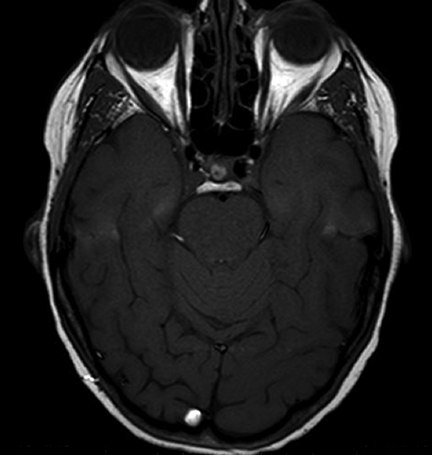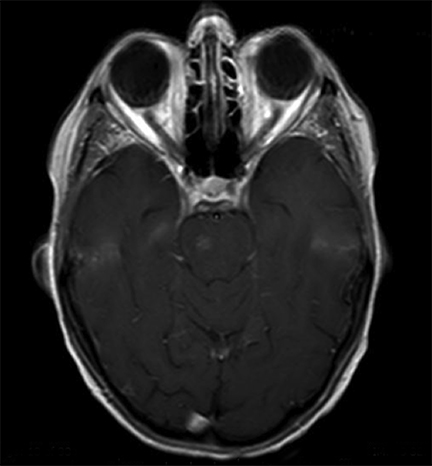Brain capillary telangiectasia
Images



CASE SUMMARY
An otherwise healthy 83-year-old female was referred by her otolaryngologist for evaluation of acute onset of left-sided hearing loss with a clinical suspicion of acoustic neuroma. Contrast-enhanced magnetic resonance imaging (MRI) of the brain and internal auditory canals were performed using T1-weighted, T2-weighted, FLAIR, gradient echo, DWI, ADC, and postgadolinium-administration T1-weighted sequences.
IMAGING FINDINGS
No evidence of mass, signal abnormality, or pathological contrast enhancement within the cerebellopontine angles or membranous labyrinths was identified. There was extensive signal abnormality within the periventricular and subcortical white matter, reflecting chronic small-vessel ischemia, but otherwise no evidence of acute infarct, hemorrhage, or mass was present. Incidentally noted was a small focus of brush-like enhancement in the right midbrain (Figures 1 and 2) with only subtle corresponding T2-signal abnormality and signal susceptibility on fast-field gradient echo sequences (Figure 3).
DIAGNOSIS
Midbrain capillary telangiectasia
DISCUSSION
Brain capillary telangiectasias are present in 0.4% of autopsies1 and represent 4% to 20% of the 4 types of intracerebral vascular malformations,2,3 which also include arteriovenous malformations, cavernous hemangiomas, and venous anomalies.1,3 No predilection has been reported for either sex or ethnicity. Brain capillary telangiectasias are commonly incidental findings on brain MRI studies3 and most often discovered in the third and fourth decades of life.2,4 Classically, brain capillary telangiectasias were considered to be congenital anomalies,3,5 but recently some authors have suggested that these malformations may be acquired, which might explain the rare incidences of these lesions in the pediatric population.2,5
Brain capillary telangiectasias are typically found in the pons,1,2,4,5 but are also commonly located in the medulla, caudate nucleus, cerebrum,3 cerebellar hemispheres, and in the spinal cord.2 The locations of rarer large brain capillary telangiectasias have been reported in the pons, basal ganglia, midbrain, temporal lobes, and parafalcine frontal lobes.1,3 Capillary telangiectasias are usually solitary findings, but may be multiple in Osler-Weber-Rendu Syndrome, ataxia-telangiectasia, and Sturge-Weber Syndrome3 or when associated with cerebral vascular accidents1,2 and other venous anomalies.2,4
Capillary telangiectasias may be differentiated from the other CNS vascular malformations in that they are usually benign, asymptomatic, and small, ranging from a few millimeters to 2 cm1,2,3 in size. Several studies have considered lesions > 1 cm large and have discovered increased incidence of associated symptoms.3,6 Symptomatic capillary telangiectasias have also been reported when associated with other vascular malformations.2 Symptoms are variable, but include headaches, hearing loss, tinnitus, vertigo, ataxia, visual disturbances, slurred speech, transient aphasia, hyperreflexia, paresthesias,1,4 progressive spastic paraparesis,3 seizures, confusion, cranial nerve or cranial nuclei palsies,6 and hemorrhage.3,5 Symptoms may mimic transient ischemic attacks and neurological inflammatory disease,4 such as multiple sclerosis, and making clinical diagnosis difficult. Proposed mechanisms of injury of symptomatic capillary telangiectasias include hemorrhage, direct compression of adjacent brain parenchyma, or local hypoperfusion, and hypoxic brain injury.3
Histologically, brain capillary telangiectasia is composed of multiple-ectatic single-walled endothelium that resemble capillary type vessels1,2,3,5 adjacent to normal brain parenchyma with occasional association with venous type channels1 or draining venous vessels.5 Findings that typically characterize other vascular malformations, such as calcifications, extraluminal hemorrhage, hemosiderin-laden macrophages, and gliosis1,2,3 are typically not seen with capillary telangiectasias. However, due to the occasional presence of venous type channels and draining veins, distinguishing capillary telangiectasias from venous anomalies histologically may at times be difficult.1
Due to the detrimental risks associated with brain biopsies, histological diagnosis of brain capillary telangiectasias is usually not available in the clinical setting.2 Diagnosis is rather mainly established based on imaging findings,5 particularly on thin-sliced, contrast-enhanced MRI. The subtlety of these lesions may make detection difficult on conventional brain MRI.3 Brain capillary telangiectasias are usually slightly hypointense or isointense on T1-weighted images1,2,4 and slightly hyperintense on T2-weighted images1,2,4 and proton-density sequences1,4 with mild “brush” or “stipple” like enhancement interspersed among normal brain parenchyma on T1-weighted images.1,2,3,4 The area of enhancement may not correspond to the actual extent of the lesion.5 Capillary telangiectasias also demonstrate increased susceptibility on gradient-echo sequences due to the presence of deoxyhemoglobin likely as a result of stagnant blood.1,2,3,4,5 Slow flow within these lesions is responsible for their lack of findings on angiography; they are classified as “angiographically occult.”1,2,3 Capillary telangiectasias are typically occult on computed tomography (CT) as well, but may demonstrate mild enhancement with intravenous contrast.1,3 The stability on follow-up examinations1,2,4 and lack of mass effect2 are other defining characteristics of brain capillary telangiectasias.
Differential diagnosis of these imaging findings depends strongly on the location, but typically include, glial brain tumors,3 lymphoma, subacute infarct, active demyelination, or acute inflammatory process, such as acute disseminated encephalomyelitis (ADEM).1 Brain capillary telangiectasias are differentiated from these other lesions by clinical presentation and absent growth, though susceptibility on gradient-echo sequences may be a useful imaging distinguisher.
No further treatments are currently suggested for brain capillary telangiectasias once the radiological diagnosis is made. Definitive tissue diagnosis again is not generally feasible due to the risks associated with pontine, midbrain, or basal ganglial biopsies. Follow up may be performed at yearly intervals to ensure stability and to confirm the diagnosis.1
CONCLUSION
Brain capillary telangiectasias are typically benign small vascular malformations found in the pons and midbrain. These lesions are usually silent on CT and angiography, but have characteristic presentations on contrast-enhanced MRI studies, specifically demonstrating susceptibility to gradient-echo sequences and “brush” or “stipple” like enhancement interspersed among normal brain parenchyma. Diagnosis is based primarily on radiographic findings and no further treatments are currently advised. Follow-up imaging may be obtained to ensure stability and to confirm the diagnosis.
REFERENCES
- Lee R, Becher MW, Benson ML, Rigamonti D. Brain Capillary Telangiectasia: MR imaging appearance and clinic histopathologic findings. Radiology. 1997;205:797-805.
- Castillo M, Morrison T, Shaw JA, Bouldin TW. MR imaging and histologic features of capillary telangiectasia of the basal ganglia. Am J Neuroradiol. 2001;22:1553-1555.
- Sayama CM, Osborn AG, Chin SS, Couldwell WT. Capillary Telangiectasias: Clinical, radiographic, and histopathological features. J Neurosurg. 2010;113:709-714.
- Scaglion C, Salvi F, Riguzzi P, Vergelli M, Tassinari CA, Mascalchi M. Symptomatic unruptured capillary telangiectasia of the brain stem: Report of three cases and review of the literature. J Neurol Neurosurg Psychiatry. 2001;71:390-393.
- Pozzati E, Marliani AF, Zucchelli M, Foschini MP, Dall’Olio M, Lanzino G. The neurovascular triad: Mixed cavernous, capillary, and venous malformations of the brainstem. J Neurosurg. 2007;107:1113-1119.
- Kapnadak SG, Mikolaenko I, Enfield K, Gress DR, Nathan BR. Odine’s curse with accompanying trigeminal and glossopharyngeal neuralgia secondary to medullary telangiectasia. Neurocrit Care. 2010;12:395-399.
Citation
Brain capillary telangiectasia. Appl Radiol.
December 4, 2013